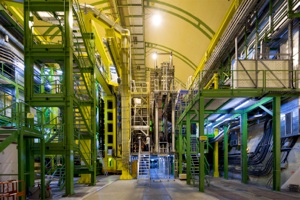PHYSICS HIGHLIGHTS - PLAIN ENGLISH SUMMARIES

MYSTERIOUS PARTICLE SEEMS TO BE ‘EXOTIC’ STATE
February 26th 2013
Summary: X(3872) particle was discovered a decade ago but its nature has been mysterious. New LHCb measurement rules out conventional interpretations and support the idea that this is an ‘exotic’ state

See also LHCb public webpage: http://lhcb-public.web.cern.ch/lhcb-public/
LHCb photo gallery https://cdsweb.cern.ch/collection/LHCb%20Photos?ln=en
Image: Photograph of the LHCb experiment on the LHC at CERN.
(Credit CERN)
New measurements performed by the LHCb collaboration, one of the four large experiments at the Large Hadron Collider at CERN, help to illuminate the nature of the mysterious X(3872) particle. The measurements rule out most conventional interpretations of the particle and support the idea that this is an ‘exotic’ state.
The protons and neutrons that make up nucleus of the atoms that we are built of contain three bound quarks. Combinations containing two bound quarks (the mesons) are also seen in nature. The underlying theory (QCD, that governs the so-called strong interactions) allows for particles containing four or more quarks to exist. Over the last forty years many searches for such have been performed for these exotics state but there is no conclusive proof of their existence.
One of the most unexpected discoveries of the last decade, was of an unconventional hadron, christened the X(3872) by the Belle experiment at KEK in Japan. The observation was quickly confirmed by several other experiments but the nature of the state remains a mystery. It was immediately clear it was a state containing charm quarks but its properties, such as its mass, do not fit any of the predicted conventional charm mesons. This has led to more exotic interpretations being put forward such as it is a state containing four quarks (a tetra-quark state) or a molecule like state consisting of two orbiting mesons.
When any new resonance is observed it is necessary to determine its fundamental properties, known as its quantum numbers. The earlier measurements left open two possibilities for these quantum numbers – one of which could be interpreted as a conventional state and one as a more ‘exotic’ state’.
The LHCb experiment is one of the four experiments at the Large Hadron Collider situated at CERN near Geneva. The large dataset collected by LHCb experiment contains the world largest sample of X(3872) meson decays. By studying the angular distributions of the particles into which the X(3872) decays LHCb has been able to unambiguously determine the quantum numbers . The measurement rules out most conventional interpretations of this state and suggests it is an exotic state.
The two competing hypothesis for this exotic paticle – that it is molecular-like state or a tetraquark - will require further studies. These will be performed by analysisng the larger dataset LHCb has collected during the LHC runs in 2012.
Dr Matthew Needham, STFC Advanced Fellow at the University of Edinburgh, and convenor of the LHCb quarkonia working group said “This measurement is a great step forward in understanding this mysterious X(3872) particle – that it is an ‘exotic’ state is a very exciting result”
“The LHCb experiment is especially designed to study particles containing the heavy quarks, the large amount of data we have collected during these first years of LHC operation will now be fully analysed during this shutdown. We will then know where to target our studies when the LHC restarts” said Prof. Chris Parkes, University of Manchester, and spokesperson for the UK involvement in the LHCb experiment.
The result will be presented for the first time at 16:30 (15:30 UK time) on February 26th 2013 at the 27th Recontres de Physique de la Vallee D'Aosta conference, La Thuile, Italy.
Technical information: The allowed quantum numbers were JPC = 1++ or 2–+. LHCb has shown that the quantum numbers are 1++ , this favours the more exotic interpretations of the particle.
Contacts:
Dr Matthew Needham, University of Edinburgh, Matthew.Needham ATNOSPAM cern.ch
Prof. Chris Parkes, University of Manchester, Spokesperson for UK participation in LHCb experiment,
LHCb-UK:
The UK participation in the international LHCb experiment is from eleven institutes.
University of Birmingham, University of Bristol, University of Cambridge, University of Edinburgh, University of Glasgow, Imperial College London, University of Liverpool, University of Manchester, University of Oxford
STFC Rutherford Appleton Laboratory, University of Warwick
UK participation in the experiment is funded by the Science and Technology Facillities Council (STFC), with contributions from the participating institutes, the Royal Society and European Union.
Scientific Paper available at
LHCb CERN web site https://cds.cern.ch/record/1519200
Previous Highlight Results
Ultra-rare Decay Spotted - November 2012
